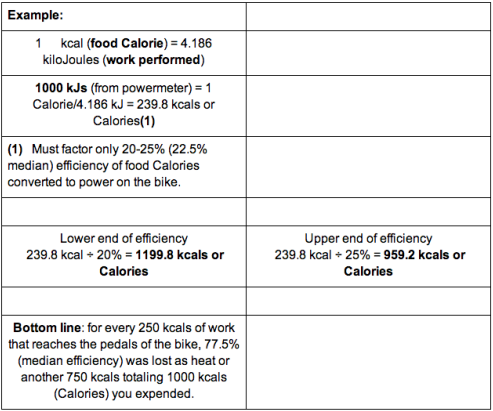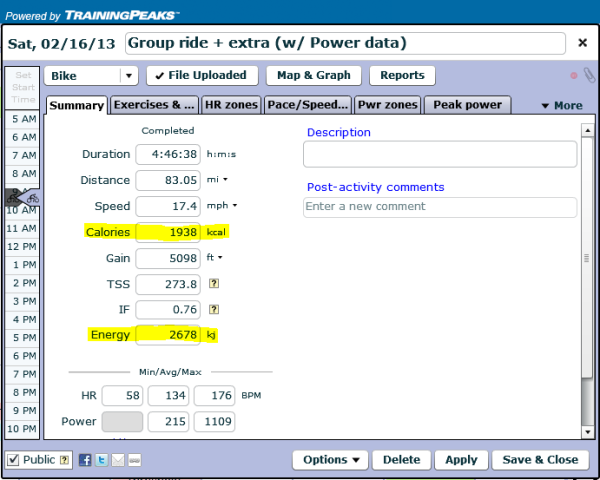In my daily routine as a full-time cycling coach I spend ample time analyzing workout files. One of the most common items I address is energy – both intake and expenditure. Often the topic is not initiated by the athlete, but something I feel is necessary to address because of how inaccurately some sources report it. It seems like every device or program has a different method for the calculation and very few individuals know what to trust.
Let’s dive in a bit deeper to explore energy expenditure on the bike as it’s calculated in three different ways: by Power, by HR, and by raw metrics. And when we’re done, hopefully you can more effectively estimate how many calories you burn cycling, and even set your TrainingPeaks Nutrition preferences for each activity, as seen here.

The Background
Most cycling devices use a hierarchy system to calculate calories burned based on what information the user inputs and the device has available. By this I mean that if the athlete has power data then it takes precedence over the heart rate calculation, and if no power data then HR is referenced and so on until finally, if only distance and time are recorded, then those metrics will be used for a rough estimate. If it comes down to the latter, let’s hope you input accurate age, height, weight, activity level, etc. within the device. The problem with digressing down this chain is that the methods become less accurate. Really, based on duration only, how does a device know the difference between coasting down a long descent essentially expending no energy toward forward motion, and covering the same ground pedaling at threshold up the same hill?
The Science
Before we get started, let’s get make sure that we are all talking about ENERGY here. Energy being expended, burned, and consumed are all functions of physics. In the case of cycling, we’re talking about stored chemical energy in the form of food, and mechanical and heat energy in the form of work. And all forms are governed by the laws of energy meaning they cannot be created or destroyed, only change form.
For clarity, some definitions from the good ol’ college physiology textbook in the Human Energy chapter will be beneficial. Energy represents the capacity to do work, and food is the source of energy for humans. The Calorie, or kilocalorie, is a measure of chemical energy stored in foods. This chemical energy can be transformed into heat and mechanical work energy in the body. A related measure of work is kilojoules, of which there are 4.186 kJs per 1 Calorie. To do work requires exerting a Force over a Distance (Work=Force x Distance) and Power is basically how fast that work is performed (Power=Work/Time). So in cycling to produce power and do work at any rate, your body will need energy in the form of calories (kcals). Your body will also lose energy in the form of heat leaving the body, since our bodies aren’t perfect and we all sweat!
Whew that’s a whole college exam in a paragraph…did you get it?! I hope at least a bit, because, now you know what someone actually means when they yell, “Do work!” as you’re attacking for a prime in a crit. They are excited you are applying force as you create distance from the group! Or when you say, “I want more power up this climb!” Yup, spot on, you want to do more work in less time to get to the top faster!
Calories Calculated with Power
I mentioned kilojoules above, but didn’t dive too far in. Let’s do so now because a common question I answer is, “What actually is a kilojoule or kJ that everyone speaks of?” For example following a hard group ride, you might hear someone say, “That was a 2300 kJ day, I’m smoked!”, or your coach could set a specific kilojoule goal for a ride or a given time frame. For example I’ll often say, “Aim for 1000 kJs today on the trainer” or “This week our goal is 4800 kJs of work.” Basically a kilojoule is a unit of work that by a fluke of nature conveniently converts in a 1:1 ratio in terms of corresponding calories burned when related to cycling. In other words, if you look at the kJs reported by your power meter on your ride, it is approximately the same as your calories expended. It sounds simple and at an accuracy rate of within 5%, I’ll take it, but if you care to know “how” this works, please read on. If not, go ahead and skip onto the next section.
Now it would seem, after reading above that 1 Calorie = 4.186 kJs, that the total kiloJoules reported from your power meter divided by 4.186 would produce your energy expenditure, right? Actually no! Here’s why: the human body isn’t 100% efficient at converting chemical energy stored within food to actual work completed (mechanical energy) on the bike. Unfortunately 75-80% of the Calories (food) are converted into heat energy that’s lost to the external environment as “waste”, while only 20-25% is actually applied to the pedals. Or I guess that could be fortunate if you are trying to burn Calories to lean up or lose excess body weight. So essentially factoring back in efficiency after dividing the Calorie to kilojoule conversion cancels out one another. Just a note, there may be a small difference based on any given rider’s efficiency, but the only way to know this is with laboratory testing, so generally 1 kilojoule equating to 1 Calorie is widely accepted in cycling.
In the example below, let’s say your power meter tells you that you expended 1000 kJ today. Here’s how that 1000 kJ’s essentially shakes out to be about 1000 calories.

Calories Calculated with Heart Rate
Measuring energy expenditure based on heart rate has come a long way over the years along with technological improvements, and more are still popping up as we speak. There are several generations of algorithms that are derived from scientific metabolic testing, so trust that the companies aren’t just throwing numbers at you. Most of the HR based calculations are within 10-20% accurate. That’s not as close as within 5% with power, but not everyone wants to or can invest in that technology.
Most all HR devices use the basic user input metrics including gender, height, weight, and activity level combined with the heart data recorded. So the main thing with HR devices is to make sure you input as much accurate information as possible. In some devices actually inputting your tested VO2max over the device-estimated value can improve the accuracy from 20% to more like 12%. Some of the more advanced methods evolving now evaluate the time between heartbeats, called beat to beat, to estimate MET (Metabolic Equivalent), which finally is used to determine actual work expenditure. And some devices also have a “learn” function that with continued use tracks your changes in fitness and adjusts the energy algorithm. So sharing a device with a family member or friend once you may not notice different results, but frequently, then you probably would.
For simply wearing a strap around your chest, the option of using HR to measure calories expended is pretty good and reliable. The only bug is interference that I often see with static electricity of jerseys or vest flapping at high speeds, or the strap electrodes not being wet at the start of a workout, so the HR data is erratic to begin until the individual works up a sufficient sweat to improve the transmission. (But, if you use TrainingPeaks.com, you can actually fix these types of errors with their Premium Data Editing features – you can fix specific bad data points or just delete choppy portions of the file).
Calories Calculated with Time and Distance
Here is where the measure of energy expenditure really is tough to blame on the device. When there is no data reported from your body, the device is left to calculate energy expenditure based on the raw metrics including time, distance (if available), age, weight, and activity level (if device has this setting). That’s why this method can range from being 20-60% off. So, really you can’t depend on calorie estimates from a device with just these metrics. For example, a ride that may actually be 600 kcals total (500 kcals to summit a climb but a minimal 100 kcals to soft-pedal back down hill) would actually report as potentially a 960 kcal activity if the 60% inaccuracy is true. That’s substantial enough in a single workout to throw off the common -500 kcal/day deficit that often person aim for to lose 1 lb/week safely.
There are some general guidelines that exist for these calculations, but as you can see by the chart they don’t take into consideration your effort level to achieve the speed. This is a large factor because quickly you can conceptualize the difference of effort that is required to pedal at these rates; into a headwind or crosswind versus a tailwind, up a steep climb versus on the flats or descending, or even on a technical mountain bike trial versus a leisurely regional gravel path.
With a few calculations from Exercise physiology text1 and fitting the generic mold of a test subject at 5’10” and 150 lbs (68kg), I didn’t have to make any corrections up or down for energy. Normally if you are heavier or lighter, one would need to make adjustments for being heavier or lighter than the “average” subject.

Example, visuals and what it all means
I’m a visual person so seeing the numbers smack me in the face speaks for itself. Here is an example personal ride where you can quickly see the difference with a glance at the metrics.
Take a look at the Energy (kJ) and Calories (kcal) stats with this ride. Based on power data an expenditure of 2678 kJs of work was performed.

Then on the other hand, the as you can see the expenditure based on HR data is 1938 Calories (this was calculated from the device using the HR data). I was actually surprised to see the difference of 28% from the Power data, but as the saying goes, “Hindsight is always 20/20!” By this I mean, the HR reactivity for this ride was lower than I typically observe, partially because my HR was suppressed due to approaching the end of a hard training microcycle that week and I happened to get sick two days later.
And finally using a speed and distance calculation from above to the same ride (28km/hr = 17.4 mph avg for 4.75 hours) the energy calculation totalled 3648 Calories! This calculation poses a 27% and 47% higher expenditure than the power data and HR data respectively. To put this in perspective that increase is equivalent to 10 gels (100 kcal each) or 17 gels when compared to the extra calories burned for the given power and HR rides.
Now with all the data outlined from measurements, hopefully you can see that the more information gathered with direct measures from your body, including power and heart rate, the more accurate the energy calculation can be. Obviously power is an objective measure so every amount of work you perform is recorded. That’s why it remains the most accurate. And even with the HR calculation algorithm being 10-20% accurate, it’s only as good as the data reported, as in this case the HR being subdued – it reports lower than expected xaloric expenditure. Finally as expected, with the least amount of input the raw calculations can vary greatly enough to the point where depending on this calculation is highly unreliable for nutrition preparation, fueling during, refueling expectations and weight management.
References
McArdle, W.D. et al. (2015, October 22). Essentials of Exercise Physiology (2nd ed.). Lippincott Williams and Wilkins.


